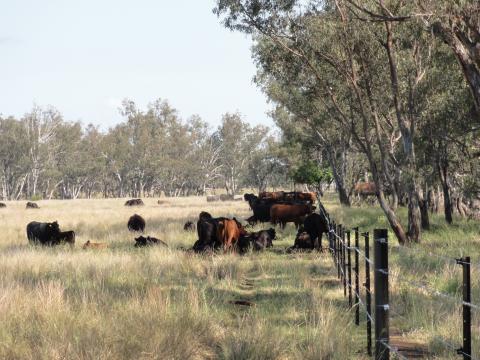By Stacey Vogel, CottonInfo NRM Technical Lead.
Domestic stock - particularly cattle - tend to favour riparian lands and if not managed carefully will spend much of their time along riverbanks and in the water, which results in a number of problems such as:
- Reduced water quality through increased manure and urine in the water,
- Increased sedimentation of rivers shallowing riverbeds and deep waterholes as banks erode from trafficking and removal of vegetation
- Simplification of riparian vegetation communities through selective grazing of native species seedlings, and
- Loss of groundcover and litter enabling invasive weeds to establish
The reduction in riparian and in-stream health for a cotton farm business can also results in
- Loss of vegetative buffers protecting aquatic environments from agricultural activities
- Reduction in provision of ecosystem services such as Natural pest control, carbon sequestration and storage, salinity mitigation & erosion control, wildlife habitat, and
- Increased public concern around agricultural practices putting the industries social license to operate at risk
Improving riparian land condition can be achieved without permanently excluding stock by using management strategies such as fencing, off-site watering points and controlling grazing pressure.
In-terms of managing grazing pressure on riparian lands, the aim is to maintain continuous groundcover and enough vegetation to protect the soil surface from eroding during heavy rainfall and provide filtering and trapping of sediments. In general the timing, intensity and duration of grazing all need to be considered.
Best practice:
- Restrict or halt grazing when native plants are young, flowering and setting seed in order to allow for continual replacement and maintenance of good vegetation cover.
- Restrict or halt grazing during the year when maximum rainfall is expected, ensuring the maintenance of a complete groundcover when erosion potential is high
- Monitor the impact of grazing when stock have access and adjust grazing intensity before damage to groundcover can occur. Recommended groundcover percentages for your areas can be obtained from your regional NRM groups.
- Do not continuously graze riparian lands as native grasses, herbs and shrubs will eventually die out and be replaced by unpalatable and weedy species.
Grazing, when undertaken conservatively and used along with other management strategies, can be an effective tool for weed suppression assisting with improving the condition of riparian land.
For more, see the Managing riparian lands in the cotton industry booklet.
This blog is part of a year long program from CottonInfo, with the themes aligned with the 2019 CottonInfo cotton calendar. For more information, view the calendar, or contact the CottonInfo Technical Lead for Natural Resources, Stacey Vogel.
The April blog is a two part blog. See Part 1 - The importance of conserving & restoring riparian zones.

